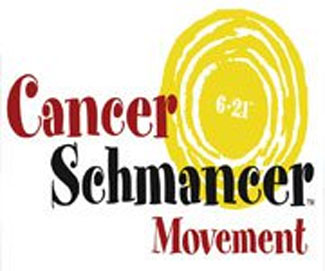Re: Shiva Ayyadurai suing TechDirt over Stories Saying He Di

Posted:
Thu Feb 23, 2017 9:34 pmby admin
Curriculum Vitae
VA Shiva Ayyadurai, Ph.D.
Chairman & CEO, CytoSolve, Inc.
Founder & Chairman, EchoMail, Inc.
Executive Director, International Center for Integrative Systems
Managing Director, General Interactive, LLC
Lecturer, MIT Comparative Media Studies
2012
Education
DEGREE / INSTITUTION AND LOCATION / YEAR(s) / FIELD
Ph.D. / MIT, Department of Biological Engineering / 2004- 2007 / Systems Biology
S.M. / MIT, Department of Mechanical Engineering / 1988-1990 / Applied Mechanics
S.M. / MIT Media Laboratory, Department of Architecture / 1987-1989 / Scientific Visualization
S.B. / MIT, Department of Electrical Engineering and Computer Science / 1986 / Operating Systems
Research Experience
2009-Present / Director, International Center for Integrative Systems
2011-Present / Research Manager, Comparative Media Studies, MIT
2008-2009 / Fulbright Research Scholar, Systems Biology and Traditional Medicines, US Fulbright Program
2004-2008 / Research Fellow, Computational Systems Biology, MIT Biological Engineering
1996-2004 / Chief Scientist, Large Scale Architectures for Message Analysis, EchoMail, Inc.
1992-1996 / Chief Technology Officer, Document Analysis & Modeling, Information Cybernetics, Inc.
1990-1992 / Research Team Leader, Handwriting Recognition, MIT Sloan School of Management
1988-1990 / Graduate Research Assistant, Wave Propagation Analysis and Modeling, MIT NDE Lab
1986-1988 / Graduate Research Fellow, Automated Graphic Design System, MIT Media Laboratory
1984-1986 / UROP Research, Particle Analysis in Fluidized Bed Reactors, MIT Langer Laboratory
1983-1984 / UROP Research, Cryogenic Embryo Preservation, MIT Health Sciences and Tech.
1981-1983 / UROP Research, Tadoma and Speech Recognition, MIT Research Lab for Electronics
1979-1981 / Research Associate, Sleep Pattern Analysis, UMDNJ Biomedical Engineering
1977-1980 / Research Associate, EMAIL System, UMDNJ Laboratory for Computer Science
Inventions
2009 – 2010 / KnowThyFace
2008 – 2009 / eMedics
2007 – 2008 / LogoCat
2003 – 2007 / CytoSolve
1999 – 2002 / Interactive.com
1994 – 1999 / EchoMail
1993 – 1994 / Arts-Online
2004 / U.S Patent: Filter for Modeling System and Method for Handling and Routing of Text Based Aynchronous Commmunications
2004 / U.S Patent: System and Method for Content-Sensitive Automatic Reply Message Generationy
2003 / U.S Patent: Relationship Management System and Method using Asynchronous Electronic Messaging
1992 – 1993 / Integrated Architecture for Handwriting Recognition
1990 – 1993 / Information Cybernetics: Generalized System for Pattern Recognition
1988 – 1990 / System for Classifying Fiber Composite Analysis
1986 – 1988 / Intelligent Design System for Graphics and Layout
1985 – 1987 / Workstation for Visualization of Fluid and Particle Motion
1983 – 1984 / Controller for CryoMicroscope System
1982 / First Copyright for EMAIL Issued by United States Copyright Office
1978 – 1981 / World's First EMAIL System
Industry & Entrepreneurial Experience
2011-Present / Chairman & CEO, CytoSolve, Inc.
2004-Present / Board Member, EchoMail, Inc.
2004-Present / Founder and Managing Director, General Interactive, LLC
1998-2004 / Founder, President & CEO, EchoMail, Inc.
1996-1998 / Founder, President & CEO, Media Production, Millennium Productions, Inc.
1994-1996 / Founder, President & CEO, Arts-Online, the first online arts community
1990-1994 / Director of Advanced Products, Dataware Technologies, Inc., CD-ROM Search Software
1986-1990 / Senior Engineer, IBM/Lotus Development Corporation, Graphics Software
1984-1986 / Senior Engineer, Information Resources, Inc., Marketing Analysis Software
1983-1984 / Consulting Software Engineer, Chase, Inc., Hydrodynamics Software
1982-1984 / Research Engineer, HP Medical Systems, Operating System for Cardiologist Workstation
1982-1983 / Consulting Software Engineer, MIT Civil Engineering, Intelligent Signal Processing
1981-1982 / Consulting Software Engineer, Number Nine, Inc., Advanced Graphics Hardware
Teaching Experience
2011 – Present / Lecturer, Systems Visualization, MIT Comparative Media Studies
2008 – 2011 / Lecturer, Systems Biology and Traditional Medicine, MIT Biological Engineering Department
2007 / Instructor, Biological Pathway Design and Implementation, MIT SMA Boot Camp
2006 / Instructor, Biological Pathway Design and Implementation, MIT SMA Boot Camp
2006 / Teaching Assistant, Control Systems and Dynamics, 2.14, MIT Mechanical Engineering
1994-2004 / Industry Expert, Dr. EMAIL Industry Lectures Worldwide, Global 2000 Companies
1992-1994 / Instructor, Information Technology I, MIT Sloan School of Management
1990 / Senior Engineer, Graphics Software, IBM/Lotus Development Corporation
1988 / Instructor, Physics, MITES Program
1987 / Teaching Assistant, Computer Graphics, 4.971, MIT Media Laboratory
1986 / Teaching Assistant, Measurements Laboratory, 2.671, MIT Mechanical Engineering
1985 / Teaching Assistant, Being There, MIT Humanities Department
1984 / Tutor, Circuits and Electronics, 6.002, MIT Electrical Engineering and Computer Science
1983 / Tutor, Structures & Programming, 6.001, MIT Electrical Engineering & Computer Science
1982 / Instructor, IAP Course on Indian Art History, MIT Humanities Department
Selected Publications
1. S. Ayyadurai, D. A. Nordsletten, B. Yankama, R. Umeton, C. F. Dewey Jr., Multi-scale Mathematical Modeling to Support Drug Development, Proceedings of Biomedical Engineering Society (BMES), Hartford, CT, October 12-15, 2011.
2. S. Ayyadurai, C.F. Dewey, Jr., CytoSolve: A Scalable Computational Method for Dynamic Integration of Multiple Molecular Pathway Models, Biological Engineering Division, MIT, Cambridge, MA, June 28, 2011.
3. S. Ayyadurai, Biomimetics of Communication and Media, 12th International Research Symposium on Service Excellence in Management,, Ithaca, NY, June 2-5, 2011.
4. S. Ayyadurai, C.F. Dewey, Jr., A Distributed Computational Architecture for Integrating Multiple Biomolecular Pathways, Biological Engineering Division, MIT, Cambridge, MA, March 9, 2011.
5. S. Ayyadurai, Services-Based Systems Architecture for Modeling the Whole Cell: A Distributed Collaborative Engineering Systems Approach, Communications in Medical and Care Compunetics, Springer Publications, 16 November 2010.
6. S. Ayyadurai, B. Yankama, R. Umeton, C. F. Dewey Jr., Editing and Aligning Complex Molecular Pathways Using 3D Models, Proceedings of Biomedical Engineering Society (BMES), Austin, TX, October 6-9, 2010.
7. S. Ayyadurai, Commentary: Innovation Demands Freedom, Nature 7. India, December, 2009.
8. S. Ayyadurai, A Scalable Computational Architecture for Integrating an Ensemble of Biological Pathway Models, (in submission to Annals of Biomedical Engineering), November 2009.
9. S. Ayyadurai, Modeling the Cell, Proceedings of BIO-IT Conference, In Silicon Modeling Section, Boston. MA, April 2009.
10. S. Ayyadurai, Integration of Siddha with Systems Biology, Proceedings of Fullbright Conference 2009, Kolkata, India, March 2009.
11. S. Ayyadurai, Eva Sciacca, C. Forbes Dewey, Jr., A Web Based Tool for Integration of Molecular Pathway Models, Proceedings of BioInformatics and BioEngineering, 8th IEEE International Conference, 8-10 Oct. 2008.
12. S. Ayyadurai, Mission of Systems Biology, Bio-IT Beyond Genome Conference Proceedings, June 2008.
13. S. Ayyadurai, C.F. Dewey, Jr., Scaleable methods for large molecular pathway calculations: application to EGFR, In Biomedical Engineering Society Annual Fall Meeting, Los Angeles, September 2007.
14. K. R. Stiehl, K. Dang, S. Ayyadurai, B.-S Seah, S. S. Bhowmick, C. Forbes Dewey, Jr., A New Approach to Database Creation Using Ontologies: OWLdb. K. Dang, K. R. Stiehl , S. Ayyadurai, B.-S Seah, S. S. Bhowmick, C. F. Dewey, Jr., An Information Architecture to Support Molecular Pathway
15. Models., In Biomedical Engineering Society Annual Fall Meeting, Los Angeles, September 2007. S. Ayyadurai, C.F. Dewey, Jr., Integrating an Ensemble of Biochemical Network Models, In International Society of Computational Biology (ISCB 2007), Vienna, July 2007.
16. S. Ayyadurai, Cytosolve, In proceedings of the Singapore MIT Symposium for Computational and Systems Biology, January 2007.
17. S. Ayyadurai, Integrating Biological Pathway Models, In MIT CSBi Oktoberfest Proceedings, Cambridge, October, 2006
18. S. Ayyadurai, C. Forbes Dewey, Jr., C. Tan, Distributed Computing of Complex Collections of Biological Pathways, In World Congress on Medical Physics and Biomedical Engineering (WC 2006), Seoul, August-September 2006.
19. S. Ayyadurai, C. F. Dewey, Jr., J. Bassingthwaighte, J. Butterworth, P. Villiger, P. Hunter, Normalization of Biological Pathways, In World Congress on Medical Physics and Biomedical Engineering (WC 2006), Seoul, August-September 2006.
20. S. Ayyadurai, C.F. Dewey, Jr., Cytosolve: A Distributed Computational Architecture for the Integration of Biomolecular Pathways, In Biomedical Engineering Society Annual Meeting, Chicago, September 2006.
21. C. F. Dewey, Jr., S. Ayyadurai, V. Rouilly, C. L. Poh, S. S. Bhowmick, J. Evans, R. I. Kitney, Footprints in the Sand: Supporting External Analysis of Medical and Biological Databases, In World Congress on Medical Physics and Biomecal Engineering (WC 2006), Seoul, August-Sept 2006.
22. S. Ayyadurai, Modeling Actin Polymerization as a System of Integrated Biomolecular Pathways, In Proceedings of the Annual MIT CSBi Oktoberfest, October 2005.
23. S. Ayyadurai, C.F. Dewey, Jr., Computing unsteady phenomenon across multiple molecular pathways, In Biomedical Engineering Society Annual Meeting, Washington, D.C., September 2005.
24. S. Ayyadurai, S. A. Cimaszewski, J. H. Williams, Jr.: Unsupervised Classification of Fiber Composite Interphases, In Proceedings of the Second International Conference on Acusto-Electronics, The American Society of Nondestructive Testing, June 24-25, 1993.
25. A. Gupta, M. V. Nagendraprasad, A. Liu, Patrick Shen-Pei Wang, S. Ayyadurai: An Integrated Architecture for Recognition of Totally Unconstrained Handwritten Numerals, In International Journal of Pattern Recognition and Artificial Intelligence, Vol. 7, No. 4, pp. 757-773, 1993.
26. G. V. Novakovic, L. E. Freed, S. Ayyadurai, H. Bernstein, Robert S. Langer and C. L. Cooney, Fluid-Dynamic Study of the Enzymatic Fluidized Bed Reactor for Blood Dehparinization, Fluidization VI, In Proceedings of the International Fluidization Conference, Banff, Canada, May 1989.
27. S. Laxminarayan, O. Mills, L. Rajaram, S. Ayyadurai, L.P. Michelson, Sleep Stage and Apnea Pattern Analysis, In Proceedings of the International Conference on Medical and Biological Engineering, Espoo, Finland, August 1985.
Patents
Patent No. 6,668,281, V.A. Shiva Ayyadurai, "Relationship management system and method using asynchronous electronic messaging", April 6, 2004.
Patent No. 6,718,368, V.A. Shiva Ayyadurai, "System and method for content-sensitive automatic reply message generation for text-based asynchronous communications", April 6, 2004.
Patent No. 6,718,367, V.A. Shiva Ayyadurai, "Filter for modeling system and method for handling and routing of text-based asynchronous communications", April 6, 2004.
Research Advisor & Thesis Support and Supervision
Ceryen Tan
MIT UROP Project, Biological Engineering,
Title: SBML API Programming for Biological Systems Integration, 2005-2007
Steven A. Cimaszewksi
MIT Masters Thesis, Mechanical Engineering,
Title: Statistical Analysis of Fiber Composite Interphase Inverse Problem, 1994.
Peter L. Sparks
MIT Bachelors Thesis, Electrical Engineering,
Title: A Hybrid Method for Segmenting Numeric Character Strings, 1991.
Matthew J. Labrador
MIT Bachelors Thesis, Electrical Engineering,
Title: The Generalized Mass-Spring Lattice Model with Damping : A Lagrangian Dynamics Approach, 1990.
Honors and Awards
The Smithsonian's National Museum of American History accepts artefacts, papers and records of invention of EMAIL from V A Shiva Ayyadurai
National Museum of American History, The Smithsonian Institution, Washington D.C, February 16, 2012
First Outstanding Scientist and Technologist of Indian Origin (STIO/H)
Council of Scientific and Industrial Research (CSIR), India, 2009
Fulbright Scholar:
US Fulbright, Washington, DC, 2008-2009
ISMB Travel Fellowship Award
ISMB 2007, Vienna, Austria, 2007
Graduate Research Fellowship
SMA Graduate Research Fellowship, 2004-2007
Communications SolutionsTM Product of the Year Award
EchoMail RMOS Product Suite, November, 2003
Customer Interactive Solutions, TMC Labs Innovation Award
EchoMail Customer Care, September, 2002
Massachusetts Interactive Media Council Award (MIMC)
Customer Support Applications, EchoMail CC/BI (Finalist) 2002
Silver Pencil Award, Integrated Branding
Wieden &Kennedy/EchoMail, cK one EMAIL Campaign, 2001
Lotus Beacon Award
EchoMail RMOS Product Suite, 2000
Best of Class Internet Commerce Expo
Customer Service & Fulfillment, EchoMail CC, 1999
Massachusetts Interactive Media Council Award (MIMC)
Groupware/Collaborative Website (Finalist) World Music, 1998
Massachusetts Interactive Media Council Award (MIMC)
Non-Profit/Public Service Online, AccessExpressed.org Online Community (Finalist), 1998
Who's Who in America
Accepted in 1997
Lotus Beacon Award
Best Messaging Solution, EchoMail Suite, 1997
Massachusetts Interactive Media Council Award
Best EMAIL/ Fax Application, EchoMail suite, 1997
Discover Magazine Award for Technical Innovation
XIVATM Core Technology, 1996
Finalist, Lemelson-MIT Award for Innovation
XIVATM Core Technology, 1996
Verizon (formerly GTE/BBN) Technologies Award
ProVision Award, Interactive Marketing Creative Direction, 1996
PCWeek's Web Site of the Week
Harvard-Square.com Online Community, 1996
Best of Europe Online
Arts-Online.com Online Community, 1996
Yahoo! #1 What's Cool
Harvard-Square.com Online Community, 1996
IBM Best Online Community
Harvard-Square.com Online Community, 1996
DISNEY EPCOT Center Award for Exhibit
Selected to be in Innoventions Exhibit, 1996
First Place, Competition for Automatic Categorization of Electronic Mail
Office of the President, White House, Washington, DC, November, 1994.
Winner, Automatic Categorization of SGML Tagged Documents
Information Handling Services (IHS), Boulder, CO, 1993
International Fellowship Research Grant, Research in the Cross-Language Translators
Sloan School of Management and Industrial Liaison Program and the Italian Trade Commission, MIT, Cambridge, MA, 1992.
Elected Session Chairman, Session on Scientific Visualization
International IEEE EMBS Conference, Institute of Electrical and Electronics Engineers (IEEE) Philadelphia, PA, 1991.
Founder and Organizer, Session on Scientific Visualization
International IEEE EMBS Conference, Institute of Electrical and Electronics Engineers (IEEE) Seattle, WA, 1990.
Full Member, SIGMA XI
Since 1989
SIGMA XI UROP Award for Outstanding Undergraduate Research
1985
MIT Mennen Scholar
1982-1986
Tau Beta Pi
1984.
ETA KAPPA NU
1984.
VI-A Hewlett-Packard COOP Assignment
Biomedical Division, Andover, MA 1983
MIT Varsity Soccer
1982
Awarded Westinghouse Science Talent Search Award
1981
Thomas Alva Edison/Max McGraw Finalist
1981
Accepted to American Legion Jersey Boys State Program
1981
Outstanding Statesman Award, American Legion Jersey Boys State
1981
All-County Soccer Champions
All-County Soccer Champions
Individual First Place in Advanced Mathematics at New Jersey State Mathematics Competition
1981
Accepted to Gifted Students Program
New York University Program in Computer Science at Courant Institute of Mathematical Sciences for gifted students in Eighth Grade of Junior High School, 1977
Skills
Programming Languages: C++, C, Java, HTML, ASP
Foreign Languages: Spanish, Italian, Tamil
General Skills: Problem Solving, Writing, Teaching and Lecturing, Fundraising, Research, Proposal Development, Software Architecture, Design and Development, User Interface Design, Mathematical Modeling, Organizational and Business Development, Crisis Management, Mentoring and Career Development, Negotiations.
Invited Lectures & Talks
MIT Lecture Series
Address: EAST MEETS WEST: Traditional Medicines + Modern Systems Biology
MIT, Cambridge, MA September 9, 2010 to December 9, 2010
Customer Response Summit
Address: PREDICTING THE FUTURE: Are You REALLY Ready to Listen?
Westin Kierland Resort & Spa, Scottsdale, AZ November 3rd & 4th, 2010
Visual Interpretations Conference
Address: Collaborative Cave Drawings of Social Interactions: Simple Visualizations of Complex Phenomena
humanities + digital Visual Interpretations Conference @ MIT, Cambridge, MA May 2010
BIO-IT Conference In Silico Biology
Address: Modeling the Cell
BIO-IT Conference, Boston, MA April 2009
Sri Ramachandra University
Address: Integration of Yogic Science and Systems Biology
Sri Ramachandra University, Chennai, IN, March 2009
SIAM Conference on Multi-Scale Systems
Address: Scalable Architecture for Integrating Multiple Biological Pathway Models
Montreal, CANADA August 2008
Genome Biology Conference - KEYNOTE SPEAKER
Address: The Mission of Systems Biology
Genome Biology Conference, San Francisco, CA June 2007
MIT UROP Panel
Address: Opportunities for Research at MIT
MIT UROP, Cambridge, MA February 2007
MIT Singapore Symposium
Address: Cytosolve
SMA Alliance Symposium, Singapore, January 2007
MIT GAME Seminar
Address: Modeling the Cell
Graduate Mechanical Engineering Students Seminar, Cambridge, MA 2005
Effective EMAIL Marketing Campaigns
Address: Measure your Success: New Metrics for EMAIL Marketing
The Institute for International Research, San Francisco, CA, February 2002
Excellence in E-CRM Conference
Address: The Big Lie of CRM
Allstate Corporation Conference Center, Northbrook, Ill. November 2001
E-Marketing / E-Service Seminar Series
Address: EMAIL Project Solutions
Cambridge Education Center, Cambridge, MA December 2001
EU Conference: Artificial Intelligence
How to Increase Banking Business and Open New Dialogue with On-line Customers
Address: E-Business Strategies for CRM
Realvision Vicenza e NTI UK Italia, Vicenza, Italy, June 2001
Pre-Conference Lecture, EMAIL2001 @ MIT Conference
Keynote Address: The Pulse of the Industry
Becton, Dickinson and Company, Franklin Lakes, New Jersey, May 2001
Nothing But New Forum at Fidelity Center for Applied Technology
Keynote Address: EMAIL Marketing Strategies
Fidelity Center for Applied Technologies, Boston, MA, April 2001
EMAIL2001@MIT Conference: Intelligent Life
Keynote Address: The Corporate Nervous System
MIT University Park Hotel, Cambridge, MA, January 2001
Southern India E-Commerce Conference 2000
Keynote Address: EMAIL = E-Commerce
Advertising Club of Madras, Chennai, India, December 2000
Le Potenzialita del Marketing On-line in Italy
Keynote Address: Marketing On-line in Italy: How It Can Be Done
Brodeur Image Time, Milan, Italy, December 2000
2000 General Motors Dealer Summit
Keynote Address: eCRM - How EMAIL Helps Your Business
Maritz Performance Improvement Company, Scottsdale, AZ, October 2000
Producing Sales in Call Centers
Keynote Address: Implementing Interactive Web
Institute of International Research, Washington, D.C., June 2000
Measuring and Managing the Quality of EMAIL Response
Keynote Address: Using Automated Systems to Improve EMAIL Response
InfoCast, San Francisco, CA, May 2000
JCPenney Internet Day
Keynote Address: EMAIL - The Ultimate Relationship Builder
JCPenney, Huston, TX, May 2000
Annual Investment Conference for Private Companies
Keynote Address: Electronic Customer Relationship Management
Massachusetts Software and Internet Council, World Trade Center, Boston, MA, April 2000
Innovators Breakfast Series
Open Discussion: The eCRM Problem
Massachusetts Institute of Technology, New York Academy of Sciences, New York, NY, April 2000
Innovators Breakfast Series
Open Discussion: The Power of EMAIL - Brand Loyalty in Real Time
Massachusetts Institute of Technology, National Press Club, Washington, D.C., April 2000
American Express, Naples Conference
Keynote Address: Electronic Customer Relationship Management
American Express, Naples, FL, March 2000
American Express, Bermuda Conference
Keynote Address: Electronic Customer Relationship Management
American Express Delivery Group, South Hampton, Bermuda, March 2000
Customer EMAIL Management
Keynote Address: Using Automated Systems to Improve EMAIL Response
International Quality & Production Center, London, England, February 2000
GM e-Wow Speaker Series: Building Customer Relationships Online
Keynote Address: Electronic Customer Relationship Management
General Motors Global Brand Management College, Detroit, Michigan, February 2000
Innovators Breakfast Series
Open Discussion: Is software That Answers EMAIL Automatically the Future of On-line Marketing?
Massachusetts Institute of Technology, Cambridge, MA, February 2000
Internet Customer Relationship Management
Keynote Address: Electronic Customer Relationship Management
The Institute for International Research, San Diego, CA, January 2000
Electronic Commerce World 1999 Conference
Educational Track: EMAIL--The Ultimate Relationship Builder
EC World 2001 Conference, Orlando, FL, October 1999
Technology Based Customer Care ICM Conference
Keynote Address: EMAIL = E-Commerce
ICM Conferences, Atlanta, Georgia, February 1999
DISNEY INSTITUTE/ OOPS Conference
Address: Object Oriented Programming, 1998
Other Seminar Leaders: Alan Kay
Industry RFP Awards
Allstate Corporation, Business Intelligence and Customer Care Technology ($1,500,000.00)
AT&T, Business Intelligence and Customer Care Technology ($120,000.00)
American Express, Business Intelligence and Customer Care Technology ($4,120,000.00)
BancOne Services Corporation, Business Intelligence and Customer Care Technology ($920,000.00)
BThree (Warner), Business Intelligence and Customer Care Technology ($520,000.00)
Bausch & Lomb, Business Intelligence and Customer Care Technology ($25,000.00)
Becton Dickinson, Business Intelligence and Customer Care Technology ($1,110,000.00)
Bush for President, Inc., Business Intelligence and Customer Care Technology ($820,000.00)
Cendant, Business Intelligence and Customer Care Technology ($20,000.00)
Citigroup, Business Intelligence and Customer Care Technology ($3,150,000.00)
Calvin Klein Cosmetics Company, Business Intelligence and Customer Care Technology ($830,000.00)
Classified Ventures, Inc., Business Intelligence and Customer Care Technology ($710,000.00)
Dial Corporation, Business Intelligence and Customer Care Technology ($110,000.00)
Entertainment Media Services, Inc., Business Intelligence and Customer Care Technology ($150,000.00)
Fireman's Fund Insurance Company, Business Intelligence and Customer Care Technology ($80,000.00)
Gateway, Business Intelligence and Customer Care Technology ($1,170,000.00)
GEICO, Business Intelligence and Customer Care Technology ($2,250,000.00)
Hasbro Interactive, Inc., Business Intelligence and Customer Care Technology ($510,000.00)
Hershey Foods Corporation, Business Intelligence and Customer Care Technology ($9,500.00)
Hilton Hotel, Business Intelligence and Customer Care Technology ($1,050,000.00)
HomePortfolio, Inc., Business Intelligence and Customer Care Technology ($315,000.00)
The IT Group, Business Intelligence and Customer Care Technology ($25,000.00)
John Hancock Financial Services, Business Intelligence and Customer Care Technology ($660,000.00)
JCPenney, Business Intelligence and Customer Care Technology ($5,230,000.00)
LA Times, Business Intelligence and Customer Care Technology ($20,000.00)
Lycos, Inc., Business Intelligence and Customer Care Technology ($670,000.00)
Kimberly Clark Corporation, Business Intelligence and Customer Care Technology ($130,000.00)
People, Business Intelligence and Customer Care Technology ($120,000.00)
Procter & Gamble Company, Business Intelligence and Customer Care Technology ($340,000.00)
Purina, Business Intelligence and Customer Care Technology ($280,000.00)
QVC, EMAIL Management: Inbound and Outbound EMAIL ($890,000.00)
Rx.com, Inc., Business Intelligence and Customer Care Technology ($70,000.00)
Salomon Smith Barney, Business Intelligence and Customer Care Technology ($120,000.00)
Silicon Graphics, Inc., Business Intelligence and Customer Care Technology ($310,000.00)
Sprint Spectrum, Business Intelligence and Customer Care Technology ($850,000.00)
TELUS Corporation, Business Intelligence and Customer Care Technology ($90,000.00)
Time Incorporated, Business Intelligence and Customer Care Technology ($45,000.00)
Turner Entertainment, Business Intelligence and Customer Care Technology ($9,500.00)
United States Senate, Business Intelligence and Customer Care Technology ($890,000.00)
Unilever Consumer Services, Business Intelligence and Customer Care Technology ($780,000.00)
Professional Art RFP Awards
Aaron Concert Management, Art Promotional Support Online Branding Grant ($15,000.00)
American Indian Contemporary Arts, Art Promotional Support Online Branding Grant ($15,000.00)
Allworth Press, Art Promotional Support Online Branding ($15,000.00)
Alvin Ailey American Dance Theater, Art Promotional Support Online Branding Grant ($80,000.00)
Art Complex Museum, Art Promotional Support Online Branding Grant ($15,000.00)
Boston Ballet, Art Promotional Support Online Branding Grant ($40,000.00)
Boston Casting Company, Art Promotional Support Online Branding Grant ($15,000.00)
Cambridge Art Cooperative, Art Promotional Support Online Branding Grant ($15,000.00)
Cambridge Multi-Cultural Art Center, Art Promotional Support Online Branding Grant ($15,000.00)
Dance Umbrella, Art Promotional Support Online Branding Grant ($15,000.00)
Fashion Cafe, Art Promotional Support Online Branding ($15,000.00)
Green Linnet/Xeonphile, Art Promotional Support Online Branding ($15,000.00)
Handel & Haydn Society, Art Promotional Support Online Branding Grant ($15,000.00)
Honolulu Academy of Arts, Art Promotional Support Online Branding Grant ($15,000.00)
International Arts Manager, Art Promotional Support Online Branding Grant ($15,000.00)
Houston Ballet, Art Promotional Support Online Branding Grant ($15,000.00)
Lyric Stage, Art Promotional Support Online Branding Grant ($15,000.00)
MMC Recordings, Art Promotional Support Online Branding ($15,000.00)
MUSICIAN Magazine, Art Promotional Support Online Branding ($40,000.00)
National Association Performing Artists Managers of America (NAPAMA), Online Branding Grant ($15,000.00)
New Age Voice, Art Promotional Support Online Branding Grant ($15,000.00)
Poetry Alive! Art Promotional Support Online Branding Grant ($15,000.00)
Sedia Furniture Design, Art Promotional Support Online Branding Grant ($15,000.00)
Sculpture Review, Art Promotional Support Online Branding Grant ($15,000.00)
Strand Theater, Art Promotional Support Online Branding Grant ($15,000.00)
Very Special Art, National, Art Promotional Support Online Branding Grant ($70,000.00)
Very Special Art, Massachusetts, Art Promotional Support Online Branding Grant ($30,000.00)
World Music, Art Promotional Support Online Branding Grant ($15,000.00)
Young Concert Artists, Art Promotional Support Online Branding Grant ($15,000.00)
ZIMA, Art Promotional Support Online Branding Grant ($15,000.00)
Books and Chapters in Books
EMAIL: The Ultimate Relationship Builder, Volume (In Progress)
Volume I, Volume II, Volume II
Author: V.A. Shiva
The Internet Publicity Guide: How to Maximize your Marketing and Promotion in Cyberspace
Author: V.A. Shiva
Publisher: Allworth Press, New York, 1997
Arts and The Internet: A Guide to the Revolution,
Author: V.A. Shiva
Publisher: Allworth Press, 1996, New York
Chapter on Electrodynamics, Dynamics,
Chapter in Book by Prof. Williams
Chapter in Communications Arts
Computer Assisted Automatic Indexing
Document Analysis Conference, October, 1994
Author: V.A. Shiva Ayyadurai, Submitted for Publication
Unsupervised Hierarchical Clustering of Fiber Interphases for Materials Classification
American Society of Non-Destructive Testing (ASNT) Conference, April, 1993
Authors: V.A. Shiva Ayyadurai, S. Cimaszewski, J.H. Williams. Jr.
Neural Network Based Hybrid System for Handwritten Character Recognition
Sloan School of Management Technical Report Fall, 1991
Author: Shiva Ayyadurai
Visualization of Wave Propogation in Anisotropic Media
Master of Science Thesis, MIT Media Laboratory February, 1990
Author: S. Ayyadurai
A Workstation for Particle Motion and Flow Analysis
IEEE Computers in Medicine, New Orleans, LA, November, 1988
Authors: Ayyadurai, Novakovic, Gordana, Langer, Bob
Blood Deheparinization in a Fluidized Bed Reactor
Proceedings of the Canadian Conference on Fluid Dynamics, 1987
Author: Novakovic, G., Ayyadurai, S., Michelson, L.
Prototype Expert System for Bridge Deck Deteriorization
Project Report to NSF, September, 1986
Authors: Maser, Ken, Schott, Jean-Pierre, Ayyadurai, Shiva
Sleep Stage and Apnea Pattern Analysis, pp. 505-506
Journal of the International Federation of Medical and Biological Engineering, Espoo Finland, August, 1985
Authors: Laximinarayan, S. Ayyadurai, S., Michelson, L.,
Ayyadurai's Four Point Theorem
The Mathematics Teacher, Spring, 1981
Author: Shiva Ayyadurai
Media Appearances
The Hindu: Fulbright-Nehru Fellowship Announcement, March, 2009
Times of India: Fulbright-Nehru Fellowship Announcement, March, 2009
MIT Tech Talk: Fulbright Scholar on New Adventure, September, 2007
Wall Street Journal: EchoMail Can Sort, Answer Deluge of EMAIL, 2001
Wall Street Journal: Amid Anthrax, Businesses Sour On U.S. Mail, 2001
Boston Business Journal: EMAIL Marketing Looks Past Spam to Viral Affection, 2001
Wall Street Journal: Mail Scare Could be Lethal for Businesses, 2001
B2B Magazine: Technology Leads Prospects to Sales, 2001
Customer Interactive Solutions: TMC Labs 2nd Annual Innovation Award, 2001
Mass High Tech's On the Move with Dyke Hendrickson, 2001
Forrester Research: "Effective Email Marketing" by Shar VanBoskirk with Charlene Li and Jennifer Parr, 2001
Customer Interactive Solutions: Solutions for EMAIL and Speech Interfaces, 2001
CFO Magazine: The Customers Always Write, by Alix Nyberg, 2001
Summit Strategies: On the Radar column by Associate Analyst Kate Claus, 2001
Business 2.0 with John Tomasic: 2001
Summit Strategies: UpFront column by Associate Analyst Kate Claus, 2001
Congress Online Project: EMAIL Overload in Congress Managing a Communications Crisis, 2001
Read Across America: Daniel Haggerty Elementary School and EchoMail, 2001
ZD Net: During a Recent Visit to India EchoMail CEO, V.A. Shiva, Meets The Press, 2001
MIT Technology Review: Dr. EMAIL Will See You Now, Cover Story by Deborah Shapley, 2000
CIO Magazine: Electronic Electorate, 2000
Tech Republic, The EMAIL Doctor is In, 2000
The Boston Globe: As far as the Senate is concerned, 'Dr. EMAIL' is in, 1999
Fast Company: The EMAIL Prescription, 1999
Internet World, Sites Invest Big in Technology to Improve Service, 1999
Fortune Magazine, Handling Customer Service on the Web, 1999
Adweek: Dr. EMAIL, 1999
Silicon India: Antidote for the EMAIL Ills, 1998
ComputerWorld: EMAIL Adds Aura to Calvin Klein Campaign, 1998
Mass High Tech: General Interactive May Rule the World of EMAIL, 1998
Continental Magazine: EchoMail's V.A. Shiva Has A Vision For The Internet That Begins With EMAIL, 1998
Exhibitor Magazine: IBM's Lead Retrieval System, 1998
Internet World: Companies Seek Solutions to EMAIL Flood, 1998
Electronic Messaging News: EchoMail® Executive Briefing, 1998
The Forrester Report: Commerce Technology Strategies, 1998
Times Union (Albany, NY) : The Web as a Black Hole, 1998
The Ann Arbor News: EMAIL Isn't Quite Down to Business, 1998
The Journal Record: Poor Response to EMAIL, 1998
The Press Democrat: Black Hole of EMAIL, 1998
The Houston Chronicle: Customer EMAIL, 1998
Integrated Marketing & Promotion: The Ultimate Relationship Builder, 1998
The New York Times: We Got Your EMAIL; Just Don't Expect a Response, 1998
Star Tribune: For Much Customer EMAIL the Web Can Be a Black Hole, 1998
Fort Worth Star Telegram: Much Internet Customer Slow as Snail Mail, 1998
Portland Press Herald: Many Companies Falter in Fielding Consumer EMAIL, 1998
Tallahassee Democrat: Companies Respond Poorly to Customer EMAIL, 1998
Mass High Tech: Millennium Clinches Olympic-Sized Deal, 1997
Andrew Ross Sorkin: Nike Ads Point Consumers to the Internet, 1997
Telephony Magazine: An E-Explosion, 1997
E-Business & Communications: IBM Solutions Strengthen Internet Service Providers for Success in "Second Wave" of the Internet, 1997
PC Week: Return to Sender , 1997
Communication Arts: The Internet Publicity Guide, 1997
Reseller Magazine: N.E. VAR Builds Very Special Intranet, 1997
Mass High Tech: Web Site Transforms the Hub into Surf City, 1996
The New York Times: Lotus Gears Up to Get a Slice of Internet Pie, 1996
Boston Business Journal: Marrying High Art with High Tech, 1996
Computer Reseller Magazine: VAR Bridges Arts, Technology Gap in Web Site Design, 1996
Re: Shiva Ayyadurai suing TechDirt over Stories Saying He Di

Posted:
Sun Feb 26, 2017 2:59 amby admin
Bob Kahnby Wikipedia
February 25, 2017
NOTICE: THIS WORK MAY BE PROTECTED BY COPYRIGHTYOU ARE REQUIRED TO READ
THE COPYRIGHT NOTICE AT THIS LINK BEFORE YOU READ THE FOLLOWING WORK, THAT IS AVAILABLE SOLELY FOR PRIVATE STUDY, SCHOLARSHIP OR RESEARCH PURSUANT TO 17 U.S.C. SECTION 107 AND 108. IN THE EVENT THAT THE LIBRARY DETERMINES THAT UNLAWFUL COPYING OF THIS WORK HAS OCCURRED, THE LIBRARY HAS THE RIGHT TO BLOCK THE I.P. ADDRESS AT WHICH THE UNLAWFUL COPYING APPEARED TO HAVE OCCURRED. THANK YOU FOR RESPECTING THE RIGHTS OF COPYRIGHT OWNERS.
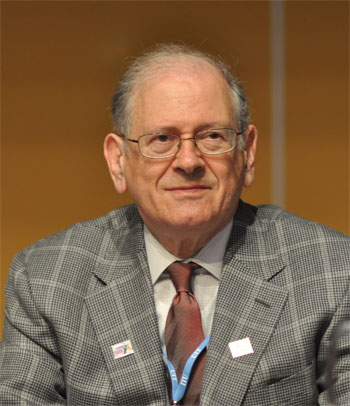
Bob Kahn in Geneva, May 2013
Born: Robert Elliott Kahn
December 23, 1938 (age 78)
Brooklyn, New York
Nationality: American
Alma mater: City College of New York (B.E.E., 1960)
Princeton University (M.A., 1962; Ph.D., 1964)
Organization:
Bell Labs
MIT
BBN
DARPACorporation for National Research Initiatives
Known for: TCP/IP
Style: Telecommunications, networking
Spouse(s): Patrice Ann Lyons
Awards:
Marconi Prize (1994) National Medal of Technology (1997) National Medal of Technology and Innovation (1997) IEEE Alexander Graham Bell Medal (1997) Charles Stark Draper Prize (2001) Prince of Asturias Award (2002) Turing Award (2004) Presidential Medal of Freedom (2005) Computer History Museum Fellow (2006) Japan Prize (2008) Harold Pender Award (2010) Queen Elizabeth Prize for Engineering (2013)
Robert Elliot "Bob" Kahn (born December 23, 1938) is an American electrical engineer, who, along with Vint Cerf, invented the Transmission Control Protocol (TCP) and the Internet Protocol (IP), the fundamental communication protocols at the heart of the Internet.
Background informationKahn was born in New York to parents Beatrice Pauline (née Tashker) and Lawrence Kahn, a high school administrator.[1][2][3] Through his father, he is related to futurist Herman Kahn.[1] After receiving a B.E.E. degree in electrical engineering from the City College of New York in 1960, Kahn earned M.A. In 1972, he began work at the Information Processing Techniques Office (IPTO) within DARPA.
In the fall of 1972, he demonstrated the ARPANET by connecting 20 different computers at the International Computer Communication Conference, "the watershed event that made people suddenly realize that packet switching was a real technology."[4] He then helped develop the TCP/IP protocols for connecting diverse computer networks. After he became Director of IPTO, he started the United States government's billion dollar Strategic Computing Initiative, the largest computer research and development program ever undertaken by the U.S. federal government.After thirteen years with DARPA, he left to found the Corporation for National Research Initiatives (CNRI) in 1986, and as of 2015 is the Chairman, CEO and President.[5]
The InternetWhile working on a satellite packet network project, he came up with the initial ideas for what later became the Transmission Control Protocol (TCP), which was intended as a replacement for an earlier network protocol, NCP, used in the ARPANET. While working on this, he played a major role in forming the basis of open-architecture networking, which would allow computers and networks all over the world to communicate with each other, regardless of what hardware or software the computers on each network used. To reach this goal, TCP was designed to have the following features:
• Small sub-sections of the whole network would be able to talk to each other through a specialized computer that only forwarded packets (first called a gateway, and now called a router).
• No portion of the network would be the single point of failure, or would be able to control the whole network.
• Each piece of information sent through the network would be given a sequence number, to ensure that they were dealt with in the right order at the destination computer, and to detect the loss of any of them.
• A computer which sent information to another computer would know that it was successfully received when the destination computer sent back a special packet, called an acknowledgement (ACK), for that particular piece of information.
• If information sent from one computer to another was lost, the information would be retransmitted, after the loss was detected by a timeout, which would recognize that the expected acknowledgement had not been received.
• Each piece of information sent through the network would be accompanied by a checksum, calculated by the original sender, and checked by the ultimate receiver, to ensure that it was not damaged in any way en route.
Vint Cerf joined him on the project in the spring of 1973, and together they completed an early version of TCP. Later, it was separated into two separate layers, with the more basic functions being moved to the Internet Protocol (IP). The two together are usually referred to as TCP/IP, and form part of the basis for the modern Internet.
In 1992 he co-founded with Vint Cerf the Internet Society, to provide leadership in Internet related standards, education, and policy.AwardsHe was awarded the SIGCOMM Award in 1993 for "visionary technical contributions and leadership in the development of information systems technology", and shared the 2004 Turing Award with Vint Cerf, for "pioneering work on internetworking, including .. the Internet's basic communications protocols .. and for inspired leadership in networking."
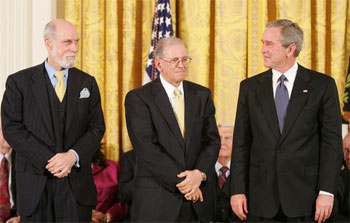 Vint Cerf and Robert Kahn being awarded the Presidential Medal Of Freedom by President Bush
Vint Cerf and Robert Kahn being awarded the Presidential Medal Of Freedom by President BushHe is a recipient of the AFIPS Harry Goode Memorial Award, the Marconi Award, the ACM SIGCOMM Award, the President's Award from ACM, the IEEE Koji Kobayashi Computer and Communications Award, the IEEE Alexander Graham Bell Medal, the IEEE Third Millennium Medal, the ACM Software Systems Award, the Computerworld/Smithsonian Award, the ASIS Special Award and the Public Service Award from the Computing Research Board.
He has twice received the Secretary of Defense Civilian Service Award.He was awarded an honorary degree by the University of Pavia in 1998.
He is a recipient of the 1997 National Medal of Technology, the 2001 Charles Stark Draper Prize from the National Academy of Engineering, the 2002 Prince of Asturias Award, and the 2004 A. M. Turing Award from the Association for Computing Machinery.[6] Kahn received the 2003 Digital ID World award for the Digital Object Architecture as a significant contribution (technology, policy or social) to the digital identity industry.
In 2005 he was awarded the Townsend Harris Medal from the Alumni Association of the City College of New York, the Presidential Medal of Freedom, and the C & C Prize in Tokyo, Japan.
He was inducted into the National Inventors Hall of Fame in May 2006.
He was inducted as a Fellow of the Computer History Museum in 2006 "for pioneering technical contributions to internetworking and for leadership in the application of networks to scientific research."[7]
He was awarded the 2008 Japan Prize for his work in "Information Communication Theory and Technology" (together with Vinton Cerf).
• In 2001 he was inducted as a Fellow of the Association for Computing Machinery.[8]
• Robert Kahn and Vinton Cerf were each inducted as an Honorary Fellow of the Society for Technical Communication (STC) in May 2006.
The duo were also awarded with the Harold Pender Award, the highest honor awarded by the University of Pennsylvania School Engineering and Applied Sciences, in February 2010.
He has also served on the board of directors for Qualcomm.
In 2012, Kahn was inducted into the Internet Hall of Fame by the Internet Society.[9]In 2013 Kahn was one of five Internet and Web pioneers awarded the inaugural Queen Elizabeth Prize for Engineering.[10]
Honorary degreesKahn has received honorary degrees from Princeton University, University of Pavia, ETH Zurich, University of Maryland, George Mason University, the University of Central Florida and the University of Pisa, and an honorary fellowship from University College, London.
In 2012 he was also recognized as honorary doctor of Saint Petersburg National Research University of Information Technologies, Mechanics and Optics.[11]
ArticlesVint Cerf & Bob Kahn, Al Gore and the Internet, 2000-09-28[12]
See alsoPaul Baran co-inventor of packet-switched networks with Donald Davies
References1. Oral History of Robert KahnArchived July 7, 2010, at the Wayback Machine.
2. Who's who in Frontiers of Science and Technology
3. Paid Notice: Deaths KAHN, LAWRENCE - New York Times. Nytimes.com (1999-04-30). Retrieved on 2013-07-24.
4. CBI oral history interview with Robert E. Kahn
5. "CNRI Officers and Directors". CNRI. Retrieved 2009-02-25.
6. "Robert E Kahn". A. M. Turing Award. ACM. 2004. Retrieved 2010-01-23. For pioneering work on internetworking, including the design and implementation of the Internet's basic communications protocols, TCP/IP, and for inspired leadership in networking.
7. CHM. "Robert Kahn — CHM Fellow Award Winner". Retrieved March 30, 2015.[1]
8. "Robert E Kahn". ACM Fellows. ACM. 2001. Retrieved 2010-01-23. For leadership in the design of the Internet, strategic computing, digital libraries, digital object infrastructure and digital intellectual property protection technology.
9. 2012 Inductees, Internet Hall of Fame website. Last accessed April 24, 2012
10. "2013 Winners Announced" Queen Elizabeth Prize for Engineering
11. Robert Kahn will receive a degree and a mantle of Honorary Doctor of Science in the University ITMO
12. Robert Kahn; Vinton Cerf (October 2, 2000). "Al Gore and the Internet". The Register. Archived from the original on 19 September 2008. Retrieved 2008-08-22.
• "Directors & Officers: Robert E. Kahn". CNRI. Retrieved 2010-01-24.
External links Wikimedia Commons has media related to Bob Kahn.
• Robert E. Kahn at DBLP Bibliography Server
• Biography of Kahn from IEEE
• Oral history interview with Robert E. Kahn, Charles Babbage Institute, University of Minnesota, Minneapolis. Focuses on Kahn's role in the development of computer networking from 1967 through the early 1980s. Beginning with his work at Bolt Beranek and Newman (BBN), Kahn discusses his involvement as the ARPANET proposal was being written, his decision to become active in its implementation, and his role in the public demonstration of the ARPANET. The interview continues into Kahn's involvement with networking when he moves to IPTO in 1972, where he was responsible for the administrative and technical evolution of the ARPANET, including programs in packet radio, the development of a new network protocol (TCP/IP), and the switch to TCP/IP to connect multiple networks.
• Bio of Robert E. Kahn from the Living Internet.
• "Morning Edition" interview (NPR)
• "Nerd TV" interview (with Robert X. Cringley) - Requires QuickTime (transcript)
• Computer Networks: The Heralds of Resource Sharing, documentary ca. 1972 about the ARPANET. Includes footage of Robert E. Kahn.
• A short history of Bob (story/slideshow) in computing, from Bob Kahn to Bob Metcalfe to Microsoft Bob and Alice & Bob
• "An Evening with Robert Kahn in conversation with Ed Feigenbaum" - Requires WMV player
• C-SPAN Q&A interview with Kahn, August 14, 2005
Re: Shiva Ayyadurai suing TechDirt over Stories Saying He Di

Posted:
Sun Feb 26, 2017 3:03 amby admin
Vint Cerfby Wikipedia
February 25, 2017
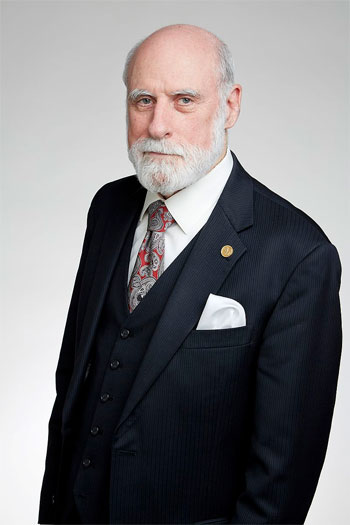
Vint Cerf at the Royal Society admissions day in 2016
Born: Vinton Gray Cerf
June 23, 1943 (age 73)
New Haven, Connecticut, U.S.
Citizenship: American
Fields: Telecommunications
Institutions:
IBM,[1] UCLA,[1] Stanford University,[1] DARPA,[1] MCI,[1][2] CNRI,[1] Google,[3]Alma mater: Stanford University
UCLA
Thesis: Multiprocessors, Semaphores, and a Graph Model of Computation (1972)
Doctoral advisor: Gerald Estrin[4]
Known for: TCP/IP
Internet SocietyNotable awards:
ACM Fellow (1994)
IEEE Alexander Graham Bell Medal (1997)
National Medal of Technology (1997)
Marconi Prize (1998)
Prince of Asturias Award (2002)
Turing Award (2004)
Presidential Medal of Freedom (2005)
Japan Prize (2008)
Harold Pender Award (2010)
Queen Elizabeth Prize for Engineering (2013)
ForMemRS (2016)[5]
Signature
Vinton Gray Cerf[1] ForMemRS,[5] (/ˈsɜːrf/; born June 23, 1943) is an American Internet pioneer, who is recognized as one of[6] "the fathers of the Internet",[7] sharing this title with TCP/IP co-inventor Bob Kahn.[8][9] His contributions have been acknowledged and lauded, repeatedly, with honorary degrees and awards that include the National Medal of Technology,[1] the Turing Award,[10] the Presidential Medal of Freedom,[11] the Marconi Prize and membership in the National Academy of Engineering.
In the early days, Cerf was a manager for the United States' Defense Advanced Research Projects Agency (DARPA) funding various groups to develop TCP/IP technology. When the Internet began to transition to a commercial opportunity during the late 1980s, Cerf moved to MCI where he was instrumental in the development of the first commercial email system (MCI Mail) connected to the Internet.
Cerf was instrumental in the funding and formation of ICANN from the start. He waited in the wings for a year before he stepped forward to join the ICANN Board, eventually becoming chairman. He was elected as the president of the Association for Computing Machinery in May 2012,[12] and in August 2013 he joined the Council on CyberSecurity's Board of Advisors.[13]
Cerf is active in many organizations that are working to help the Internet deliver humanitarian value in our world today. He is supportive of innovative projects that are experimenting with new approaches to global problems, including the digital divide, the gender gap, and the changing nature of jobs. Cerf is also known for his sartorial style, typically appearing in three-piece suit—a rarity in an industry known for its casual dress norms.[14][15]
Life and career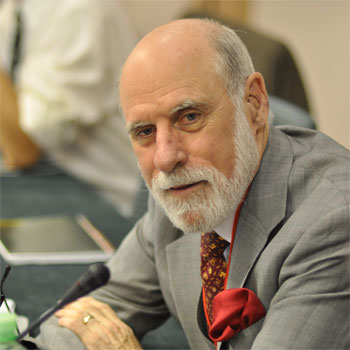 Vinton Cerf in Vilnius, September 2010Cerf was born in New Haven, Connecticut, the son of Muriel (née Gray), a housewife, and Vinton Thruston Cerf, an aerospace executive.[16][17] Cerf went to Van Nuys High School in California along with Jon Postel and Steve Crocker; he wrote the former's obituary. Both were also instrumental in the creation of the Internet. Whilst in high school, Cerf worked at Rocketdyne on the Apollo program, including helping to write statistical analysis software for the non-destructive tests of the F-1 engines.[18] Cerf's first job after obtaining his B.S. degree in mathematics from Stanford University was at IBM, where he worked for two years as a systems engineer supporting QUIKTRAN.[1]
Vinton Cerf in Vilnius, September 2010Cerf was born in New Haven, Connecticut, the son of Muriel (née Gray), a housewife, and Vinton Thruston Cerf, an aerospace executive.[16][17] Cerf went to Van Nuys High School in California along with Jon Postel and Steve Crocker; he wrote the former's obituary. Both were also instrumental in the creation of the Internet. Whilst in high school, Cerf worked at Rocketdyne on the Apollo program, including helping to write statistical analysis software for the non-destructive tests of the F-1 engines.[18] Cerf's first job after obtaining his B.S. degree in mathematics from Stanford University was at IBM, where he worked for two years as a systems engineer supporting QUIKTRAN.[1] He left IBM to attend graduate school at UCLA where he earned his M.S. degree in 1970 and his PhD degree in 1972.[4][19] During his graduate student years, he studied under Professor Gerald Estrin, worked in Professor Leonard Kleinrock's data packet networking group that connected the first two nodes of the ARPANet,[20] the predecessor[20] to the Internet, and "contributed to a host-to-host protocol" for the ARPANet.[21] While at UCLA, he also met Bob Kahn, who was working on the ARPANet hardware architecture.[21] After receiving his doctorate, Cerf became an assistant professor at Stanford University from 1972–1976, where he conducted research on packet network interconnection protocols and co-designed the DoD TCP/IP protocol suite with Kahn.[21] Cerf then moved to DARPA in 1976, where he stayed until 1982.
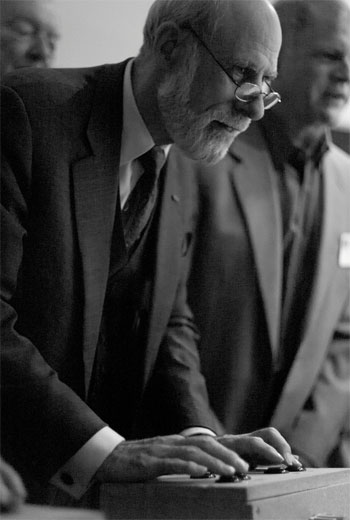 Cerf playing Spacewar! on the Computer History Museum's PDP-1, ICANN meeting, 2007As vice president of MCI Digital Information Services from 1982 to 1986, Cerf led the engineering of MCI Mail, the first commercial email service to be connected to the Internet.
Cerf playing Spacewar! on the Computer History Museum's PDP-1, ICANN meeting, 2007As vice president of MCI Digital Information Services from 1982 to 1986, Cerf led the engineering of MCI Mail, the first commercial email service to be connected to the Internet. In 1986, he joined Bob Kahn at the Corporation for National Research Initiatives as its vice president, working with Kahn on Digital Libraries, Knowledge Robots, and gigabit speed networks. It was during this time,
in 1992, that he and Kahn, among others, founded the Internet Society (ISOC) to provide leadership in education, policy and standards related to the Internet. Cerf served as the first president of ISOC. Cerf rejoined MCI during 1994 and served as Senior Vice President of Technology Strategy. In this role, he helped to guide corporate strategy development from a technical perspective. Previously, he served as MCI's senior vice president of Architecture and Technology, leading a team of architects and engineers to design advanced networking frameworks, including Internet-based solutions for delivering a combination of data, information, voice and video services for business and consumer use.
During 1997, Cerf joined the Board of Trustees of Gallaudet University, a university for the education of the deaf and hard-of-hearing.[22] Cerf himself is hard of hearing.[23] He has also served on the university's Board of Associates.[24]
Cerf, as leader of MCI's internet business, was criticized due to MCI's role in providing the IP addresses used by Send-Safe.com, a vendor of spamware that uses a botnet in order to send spam. MCI refused to terminate the spamware vendor.[25][26] At the time, Spamhaus also listed MCI as the ISP with the most Spamhaus Block List listings.[27]
Cerf has worked for Google as a Vice President and Chief Internet Evangelist since October 2005.[3] In this function he has become well known for his predictions on how technology will affect future society, encompassing such areas as artificial intelligence, environmentalism, the advent of IPv6 and the transformation of the television industry and its delivery model.[28]
Since 2010, Cerf has served as a Commissioner for the Broadband Commission for Digital Development, a UN body which aims to make broadband internet technologies more widely available.
Cerf joined the board of the Internet Corporation for Assigned Names and Numbers (ICANN) in 1999, and served until November 2007.[29] He was chairman from November 2000 to his departure from the Board.
Cerf was a member of Bulgarian President Georgi Parvanov's IT Advisory Council (from March 2002 – January 2012). He is also a member of the Advisory Board of Eurasia Group, the political risk consultancy.[30]
Cerf is also working on the Interplanetary Internet, together with NASA's Jet Propulsion Laboratory and other NASA laboratories. It will be a new standard to communicate from planet to planet, using radio/laser communications that are tolerant of signal degradations including variable delay and disruption caused, for example, by celestial motion.[31]On February 7, 2006, Cerf testified before the U.S. Senate Committee on Commerce, Science, and Transportation's hearing on network neutrality. Speaking as Google's Chief Internet Evangelist, Cerf noted that nearly half of all consumers lacked meaningful choice in broadband providers and expressed concerns that without network neutrality government regulation, broadband providers would be able to use their dominance to limit options for consumers and charge companies like Google for their use of bandwidth.[32]
Cerf currently serves on the board of advisors of Scientists and Engineers for America, an organization focused on promoting sound science in American government.[33] He also serves on the advisory council of CRDF Global (Civilian Research and Development Foundation) and was on the International Multilateral Partnership Against Cyber Threats (IMPACT) International Advisory Board.[34]
Cerf is chairman of the board of trustees of ARIN, the Regional Internet Registry (RIR) of IP addresses for United States, Canada, and part of the Caribbean.[35] Until Fall 2015, Cerf chaired the board of directors of StopBadware, a non-profit anti-malware organization that started as a project at Harvard University's Berkman Center for Internet & Society.[36][37] Cerf is on the board of advisors to The Liquid Information Company Ltd of the UK, which works to make the web more usefully interactive and which has produced the Mac OS X utility called ‘Liquid'.[38] Vint Cerf is a member of the CuriosityStream Advisory Board.[39]
During 2008 Cerf chaired the Internationalized domain name (IDNAbis) working group of the IETF.[40]
In 2008 Cerf was a major contender to be designated the US's first Chief Technology Officer by President Barack Obama.[41] Cerf is the co-chair of Campus Party Silicon Valley, the US edition of one of the largest technology festivals in the world, along with Al Gore and Tim Berners-Lee.[42] From 2009–2011, Cerf was an elected member of the Governing Board of the Smart Grid Interoperability Panel (SGIP). SGIP is a public-private consortium established by NIST in 2009 and provides a forum for businesses and other stakeholder groups to participate in coordinating and accelerating development of standards for the evolving Smart Grid.[43] Cerf was elected to a two-year term as President of the Association for Computing Machinery (ACM) beginning July 1, 2012.[44]
On January 16, 2013, US President Barack Obama announced his intent to appoint Cerf to the National Science Board.[45]
Cerf is also among the 15 members of governing council of International Institute of Information Technology, Hyderabad.[46]
In June 2016 his work with NASA lead to Delay-tolerant networking being installed on the International Space station with an aim towards Interplanetary Internet.[47]
Awards and honors Cerf and Bob E. Kahn being awarded the Presidential Medal of Freedom by President George W. Bush
Cerf and Bob E. Kahn being awarded the Presidential Medal of Freedom by President George W. Bush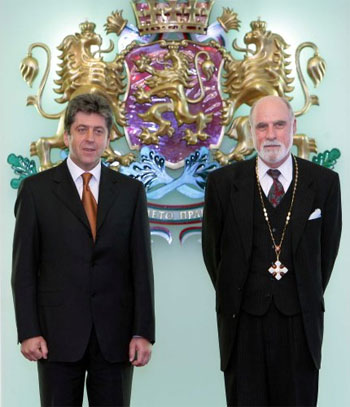 Cerf and Bulgarian President Parvanov being awarded the St. Cyril and Methodius in the Coat of Arms Order
Cerf and Bulgarian President Parvanov being awarded the St. Cyril and Methodius in the Coat of Arms OrderCerf has received a number of honorary degrees, including doctorates, from the University of the Balearic Islands, ETHZ in Zurich, Switzerland, Capitol College, Gettysburg College, Yale University, George Mason University, Marymount University, Bethany College (Kansas), University of Pisa, University of Rovira and Virgili (Tarragona, Spain), Rensselaer Polytechnic Institute, Luleå University of Technology (Sweden), University of Twente (Netherlands), Beijing University of Posts and Telecommunications, Tsinghua University (Beijing), Brooklyn Polytechnic, UPCT (University of Cartagena, Spain), Zaragoza University (Spain), University of Reading (United Kingdom), Royal Roads University (Canada), MGIMO (Moscow State University of International Relations), Buenos Aires Institute of Technology (Argentina), Polytechnic University of Madrid, Keio University (Japan), University of South Australia (Australia),
University of St Andrews (Scotland), University of Pittsburgh and [48] Gallaudet University (United States). Other awards include:
• ACM Fellow (1994)
• Edward A. Dickson Alumnus of the Year Award from UCLA[49]
•
Prince of Asturias award for science and technology• Fellow of the IEEE, 1988, "for contributions and leadership in the design, development, and application of internet protocols"
• Fellow of the Association for Computing Machinery, 1994, for "vision and leadership in the design, implementation, evolution, and dissemination of the TCP/IP computer communication protocol suite"
• Yuri Rubinsky Memorial Award, 1996
• SIGCOMM Award for "contributions to the Internet [spanning] more than 25 years, from development of the fundamental TCP/IP protocols".[50]
• Certificate of Merit from The Franklin Institute, in 1996.
•
In December 1997 he, along with his partner Robert E. Kahn, was presented with the National Medal of Technology by President Bill Clinton, "for creating and sustaining development of Internet Protocols and continuing to provide leadership in the emerging industry of internetworking."[51][52]
•
He received the Living Legend Medal from the Library of Congress in April 2000• In 2000, he was made a Fellow of the Computer History Museum "for his contributions to computer architecture, operating systems, and software engineering."[53]
• Cerf was selected as a
Fellow of the Association for Women in Science (AWIS) in 2000.
• Cerf was awarded the Award of Technology from the Telluride Tech Festival in 2002, also known as the Tesla Festival since the world's first AC hydro-power power plant was built in Telluride in 1891 by L.L. Nunn who purchased the generator and plans from George Westinghouse and Tesla.
•
Cerf and Kahn were the winners of the Turing Award for 2004,[10] for their "pioneering work on internetworking, including .. the Internet's basic communications protocols .. and for inspired leadership in networking."[54]
•
In November 2005, Vinton Cerf and Kahn were awarded the Presidential Medal of Freedom by President George W. Bush for their contributions to the creation of the Internet.[11]
•
He and Robert Kahn were inducted into the National Inventors Hall of Fame in May 2006•
Vinton Cerf was awarded the St. Cyril and Methodius in the Coat of Arms Order in July 2006[55]
• Vinton Cerf and Robert Kahn were each inducted as an Honorary Fellow of the Society for Technical Communication (STC) in May 2006
• He and Robert Kahn were awarded the Japan Prize in January 2008.[56]
•
Cerf was inducted into the Worshipful Company of Information Technologists and given the Freedom of the City of London in April 2008.
•
Cerf was awarded an honorary membership in the Yale Political Union after keynoting a lively debate on the subject "Resolved: Online Communities are Real Communities." The motion passed.[57]
• In celebration of the five year-anniversary of YouTube he was selected as a guest curator by the site, and chose the six videos on YouTube he found most memorable.[58]
• In May 2011, he was awarded an HPI Fellowship as “[...]a tribute to his work for a new medium which influenced the everyday life of our society like no other one.”[59]
• In September 2011 he was made a distinguished fellow of British Computer Society, in recognition of his outstanding contribution and service to the advancement of computing.[60]
•
In 2012 he was inducted as a Pioneer into the Internet Hall of Fame[61]
•
In 2013, Cerf was one of five Internet and Web pioneers awarded the inaugural Queen Elizabeth Prize for Engineering.[62]
• In 2013, Cerf presented the Bernard Price Memorial Lecture[63]
•
In 2014, Cerf was awarded the Order of the Cross of Terra Mariana, 1st class for his role in invention of TCP/IP by president of Estonia Toomas Hendrik Ilves[64]
• In 2014, Cerf was awarded Officer of the French Légion d'honneur[citation needed][65]
• Cerf was elected a Foreign Member of the Royal Society (ForMemRS) in 2016[5]
See alsoList of pioneers in computer science
Partial bibliography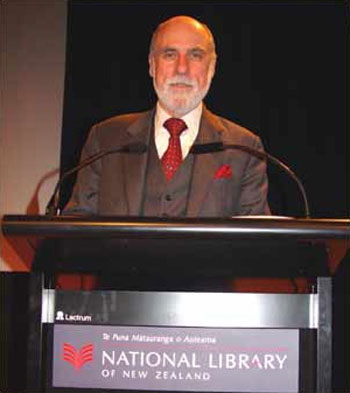 Cerf speaking at the National Library of New Zealand
Cerf speaking at the National Library of New Zealand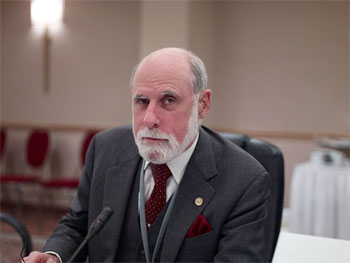 Cerf at 2007 Los Angeles ICANN meeting
Cerf at 2007 Los Angeles ICANN meeting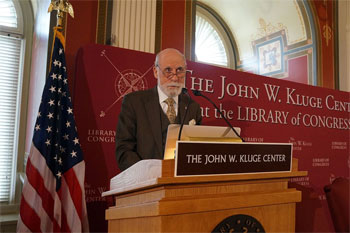 Cerf at the 2016 Saving the Web event at the Library of Congress.
Cerf at the 2016 Saving the Web event at the Library of Congress.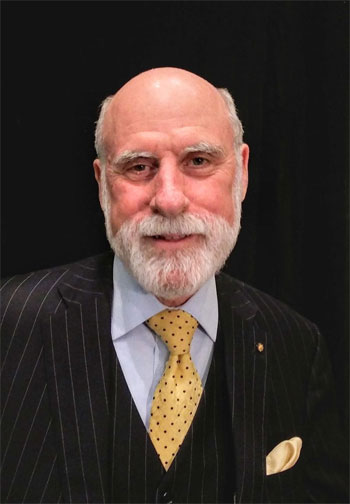 Vint Cerf, before his talk in memory of Dr. John Niparko at the 2017 MidWinter Meeting of the Association for Research in Otolaryngology in BaltimoreAuthor
Vint Cerf, before his talk in memory of Dr. John Niparko at the 2017 MidWinter Meeting of the Association for Research in Otolaryngology in BaltimoreAuthor• Zero Text Length EOF Message (RFC 13, August 1969)
• IMP-IMP and HOST-HOST Control Links (RFC 18, September 1969)
• ASCII format for network interchange (RFC 20, October 1969)
• Host-host control message formats (RFC 22, October 1969)
• Data transfer protocols (RFC 163, May 1971)
• PARRY encounters the DOCTOR (RFC 439, January 1973)
• 'Twas the night before start-up (RFC 968, December 1985)
• Report of the second Ad Hoc Network Management Review Group, RFC 1109, August 1989
• Internet Activities Board, RFC 1120, September 1989
• Thoughts on the National Research and Education Network, RFC 1167, July 1990
• Networks, Scientific American Special Issue on Communications, Computers, and Networks, September 1991
• Guidelines for Internet Measurement Activities, October 1991
• A VIEW FROM THE 21ST CENTURY, RFC 1607, April 1, 1994
• An Agreement between the Internet Society and Sun Microsystems, Inc. in the Matter of ONC RPC and XDR Protocols, RFC 1790, April 1995
• I REMEMBER IANA, RFC 2468, October 17, 1998
• Memo from the Consortium for Slow Commotion Research (CSCR, RFC 1217, April 1, 1999
• The Internet is for Everyone, RFC 3271, April 2002
Co-author• Vinton Cerf, Robert Kahn, A Protocol for Packet Network Intercommunication(IEEE Transactions on Communications, May 1974)
• Vinton Cerf, Y. Dalal, C. Sunshine, Specification of Internet Transmission Control Program (RFC 675, December 1974)
• Vinton Cerf, Jon Postel, Mail transition plan (RFC 771, September 1980)
• Vinton Cerf, K.L. Mills Explaining the role of GOSIP, RFC 1169, August 1990
• Clark, Chapin, Cerf, Braden, Hobby, Towards the Future Internet Architecture, RFC 1287, December 1991
• Vinton Cerf et al., A Strategic Plan for Deploying an Internet X.500 Directory Service, RFC 1430, February 1993
• Vinton Cerf & Bob Kahn, Al Gore and the Internet, 2000-09-28[66]
• Vinton Cerf et al., Internet Radio Communication System July 9, 2002, U.S. Patent 6,418,138
• Vinton Cerf et al., System for Distributed Task Execution June 3, 2003, U.S. Patent 6,574,628
• Vinton Cerf et al., Delay-Tolerant Networking Architecture (Informational Status), RFC 4838, April 2007
References1. Cerf's curriculum vitae as of February 2001, attached to a transcript of his testimony that month before the United States House Energy Subcommittee on Telecommunications and the Internet, from ICANN's website
2. Gore Deserves Internet Credit, Some Say, a March 1999 Washington Post article
3. Cerf's up at Google, from the Google Press Center
4. Cerf, Vinton (1972). Multiprocessors, Semaphores, and a Graph Model of Computation (PhD thesis). University of California, Los Angeles. OCLC 4433713032.
5. Anon (2016). "Dr Vint Cerf ForMemRS". London: Royal Society. Archived from the original on 2016-04-29. One or more of the preceding sentences incorporates text from the royalsociety.org website where:
“All text published under the heading 'Biography' on Fellow profile pages is available under Creative Commons Attribution 4.0 International License.” --Royal Society Terms, conditions and policies at the Wayback Machine (archived September 25, 2015)
6. (see Interview with Vinton Cerf, from a January 2006 article in Government Computer News), Cerf is willing to call himself one of the internet fathers, citing Bob Kahn and Leonard Kleinrock in particular as being others with whom he should share that title.
7. Cerf, V. G. (2009). "The day the Internet age began". Nature. 461 (7268): 1202–1203. doi:10.1038/4611202a. PMID 19865146.
8. "ACM Turing Award, list of recipients". Awards.acm.org. Retrieved December 2, 2011.
9. "IEEE Alexander Graham Bell Medal". Ieee.org. July 7, 2009. Retrieved December 2, 2011.
10. Cerf wins Turing Award February 16, 2005
11. 2005 Presidential Medal of Freedom recipients from the White House website
12. ACM Elects Vint Cerf as President from the ACM website
13. "Advisory Board", Council on CyberSecurity website. Retrieved September 27, 2013.
14. "Internet pioneer Vint Cerf looks to the future", Todd Bishop, Seattle P-I, July 23, 2007. Retrieved September 27, 2013.
15. Ghosh, Pallab. "Google's Vint Cerf warns of 'digital Dark Age'". BBC News. BBC. Retrieved 13 February 2015.
16. Jerome, Richard (September 18, 2000). "Lending An Ear – Health, Real People Stories". People. Retrieved December 2, 2011.
17. "Vinton Gray Cerf Biography". BookRags.com. Retrieved December 2, 2011.
18. Wientjes, Greg (2011). Creative Genius in Technology : Mentor Principles from Life Stories of Geniuses and Visionaries of the Singularity. p. 93. ISBN 978-1463727505.
19. "UCLA School of Engineering Alumnus Chosen for Prestigious Turing Award". UCLA Henry Samueli School of Engineering and Applied Science. Spring 2005.
20. "Internet predecessor turns 30". CNN. 1999-09-02. Archived from the original on July 25, 2008.
21. "INTERNET PIONEERS CERF AND KAHN TO RECEIVE ACM TURING AWARD". ACM. 2005-02-16.
22. Dr. Vinton G. Cerf Appointed to Gallaudet University's Board of Trustees, from that university's website
23. "Vinton Cerf – Father of the Internet, Vinton Cerf". Deafness.about.com. August 28, 2010. Retrieved December 2, 2011.
24. "Board of Associates". Gallaudet University. Retrieved April 3, 2014.
25. Socks the Whitehouse Cat (February 19, 2005). "Re: ACM ethics complaint against Cerf – first draft". Newsgroup: comp.org.acm. Retrieved June 9, 2014.
26. McWilliams, Brian (February 16, 2005). "Protest brewing against Internet pioneer". Spam Kings Blog. Retrieved June 9, 2014.
27. Socks the Whitehouse Cat (February 25, 2005). "ACM ethics complaint against Cerf – first draft". Newsgroup: comp.org.acm. Retrieved June 9, 2014.
28. The Daily Telegraph, August 2007
29. "ICANN Board of Directors – Vinton G. Cerf". Icann.org. February 14, 2011. Retrieved December 2, 2011.
30. "Eurasia Group". Eurasia Group. Retrieved December 2, 2011.
31. "The InterPlaNetary Internet Project IPN Special Interest Group". Ipnsig.org. Retrieved December 2, 2011.
32. "Testimony before the U.S. Senate Committee on Commerce" (PDF). Retrieved December 2, 2011.
33. SEA’s Board of Advisors. sefora.org
34. "Govt red tape adds to security threats", Vivian Yeo, ZDNet, October 12, 2009
35. "ARIN Announces Newly Elected Board of Trustees". Arin.net. Retrieved December 2, 2011.
36. "Board of Directors". StopBadware. Retrieved January 19, 2013.
37. "Harvard's Berkman Center and the Oxford Internet Institute Unveil StopBadware.org Backed by Google, Lenovo, Sun; Consumer Reports WebWatch Takes Unpaid Special Advisor Role". StopBadware. January 23, 2006. Retrieved December 2, 2011.
38. "The Liquid Information Company". Liquid.info. Retrieved July 1, 2013.
39. "CuriosityStream Advisory Board". Retrieved 31 August 2015.
40. "IDNAbis WG". Tools.ietf.org. Retrieved December 2, 2011.
41. "The 5 best jobs Obama has yet to fill – Craig Gordon and Ben Smith". Politico.Com. December 4, 2008. Retrieved December 2, 2011.
42. Daniel Ben-Horin (November 21, 2011). "The Kids Are Alright: Campus Party, Silicon Valley Tech Festival Rocks NASA". Huffington Post. Retrieved March 6, 2013.
43. "Smart Grid Interoperability Panel Launched; Governing Board Elected". Retrieved November 19, 2009.
44. "ACM Elects Vint Cerf as President". ACM. Retrieved May 25, 2012.
45. "President Obama Announces More Key Administration Posts". Retrieved January 20, 2013.
46. "Governing Council". International Institute of Information Technology, Hyderabad. Retrieved April 18, 2016.
47. Mahoney, Erin (21 June 2016). "Space Internet Technology Debuts on the International Space Station".
48. [1], website news archive, last accessed June 24, 2015
49. "Vinton Cerf M.S. '70, PhD '72 | UCLA Alumni". Alumni.ucla.edu. Retrieved December 2, 2011.
50. "SIGCOMM Awards". Sigcomm.org. Retrieved December 2, 2011.
51. "Office of Science and Technology Policy | The White House". Ostp.gov. Retrieved December 2, 2011.
52. "National Medals of Science and Technology Foundation".
53. "Vinton Cerf". Computer History Museum. Retrieved 2013-05-23.
54. "ACM: Fellows Award / Vinton G. Cerf". amturing.acm.org. June 4, 2011. Retrieved December 2, 2011.
55. "ISOC-Bulgaria: IT-delegation in Sofia". Isoc.bg. Retrieved December 2, 2011.
56. 2008 (24th) Japan Prize Laureate[dead link]
57. MINUTES OF THE FLOOR MEETING OF THE YALE POLITICAL UNION. Yale.edu, April 15, 2009
58. FiveYear. "Vint Cerf's Top YouTube Videos". Youtube. Retrieved December 2, 2011.
59. “Vinton G. Cerf, who developed together with Robert E. Kahn the TCP/IP protocol was awarded as a HPI Fellow on May 25th 2011. The HPI award is a tribute to his work for a new medium which influenced the everyday life of our society like no other one.” "HPI Fellows & Guests". Retrieved 2011-05-27.
60. British Computer Society. "Vint Cerf named BCS Distinguished Fellow". Retrieved September 28, 2011.
61. 2012 Inductees, Internet Hall of Fame website. Last accessed April 24, 2012
62. "2013 Winners Announced" Queen Elizabeth Prize for Engineering
63. "62nd Bernard Price Memorial Lecture". South African Institute of Electrical Engineers (SAIEE). September 5, 2013. Retrieved 25 September 2015.
64. "Bearers of decorations – Vinton Gray Cerf". Retrieved 25 September 2015.
65. "Vinton Cerf Appointed an Officer of the Legion of Honor".
66. Thomas C Greene (2000-10-02). "Net builders Kahn, Cerf recognise Al Gore: Grateful for the inventor's genius". The Register (UK). Archived from the original on 2013-12-13. Retrieved December 2, 2011.
Further reading• Cerf, Vinton G. (April 24, 1990), Oral history interview with Vinton G. Cerf, Minnesota, Minneapolis: Charles Babbage Institute
• Cerf, Vinton (May 17, 1999), Dr. Vinton Cerf: An Interview Conducted by David Hochfelder, Institute of Electrical and Electronics Engineers
External links Wikimedia Commons has media related to Vint Cerf.
Bio at Google
Vint Cerf on the ICANN wiki
Dr. Vint Cerf on "Reinventing the Internet" (YouTube). Internet Society. (May 13, 2013)
Vint Cerf at TED Edit this at Wikidata


